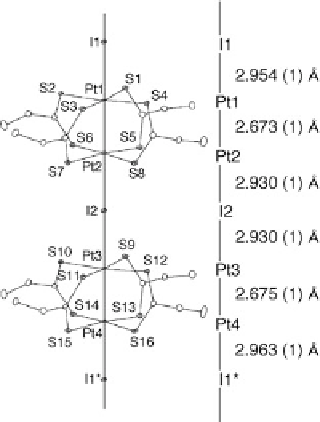Chemistry Reference
In-Depth Information
Fig. 9.22 1D chain structure
of [Pt
2
(EtCS
2
)
4
I]
1
(2)at48K
with an atomic numbering
scheme and relevant
interatomic distances
(thermal ellipsoid set at the
50 % probability level) [
33
]
2.675(1)
˚
), but
there are two different Pt-I bond distances. The short Pt-I distances (Pt2-I2
distances are almost the same (Pt1-Pt2
¼
2.673(1) and Pt3-Pt4
¼
¼
2.930
2.930(1)
˚
) are about 0.029
˚
(1) and Pt3-I2
¼
less than the long Pt-I distances
2.963(1)
˚
). The twofold superstructure
originates from the different Pt-I distances since the structures of the two crystallo-
graphic independent [Pt
2
(EtCS
2
)
4
] units are almost the same and twisting
between the dinuclear units has not occurred. The observed Pt-Pt and Pt-I
distances indicate that the valence-ordered state in the LT phase is the ACP state
of -Pt
2+
-Pt
3+
-I
-Pt
3+
-Pt
2+
-I
-, similarly to the structure of 4 in the LT phase [
33
].
Kobayashi and Kitagawa have reported from
129
IM¨ssbauer spectroscopy of 2 that
the chain structure and oxidation states of iodine in 2 at 11 K are considered to be as
follows [
26
,
74
]:
(Pt1-I1
¼
2.954(1) and Pt4-I1*
¼
Pt
2
þ
Pt
3
þ
I
A
0
:
41
Pt
3
þ
Pt
2
þ
I
B
0
:
31
The valence state of Pt expressed as a -[Pt
3+
-Pt
2+
]- represents a formal oxidation
number. Almost the same results for the M¨ssbauer parameters have also been
observed in 1, indicating the existence of ACP type ground state in the both
compounds [
26
,
31
,
74
].
9.2.6.2
[Pt
2
(n-PrCS
2
)
4
I]
1
(3)
X-ray diffraction photographs of [Pt
2
(
n
-PrCS
2
)
4
I]
1
(3) measured by rotating
around the
c
axis using synchrotron radiation are shown in Fig.
9.23
[
34
].
At 300 K, weak but distinct Bragg spots were observed in the reciprocal positions
indexed as
l
1/3 (
c
*
RT
)and
l þ
1/2 (3/2
c
*
RT
), where the
l
(3
c
*
RT
)is

Search WWH ::

Custom Search